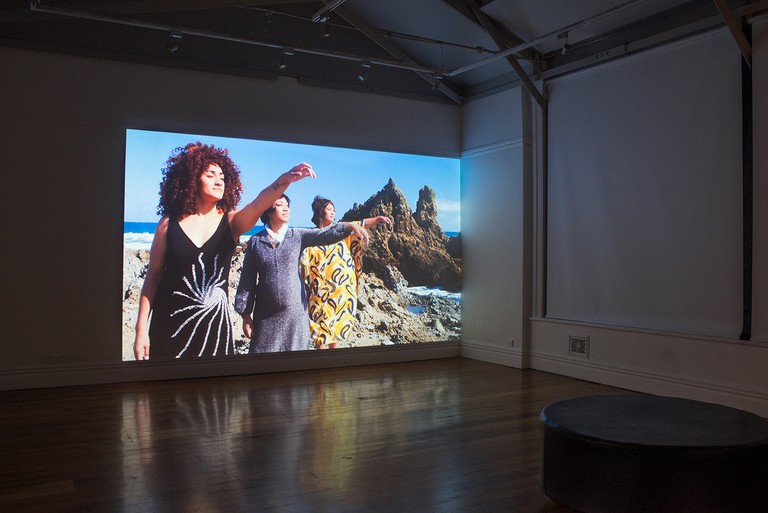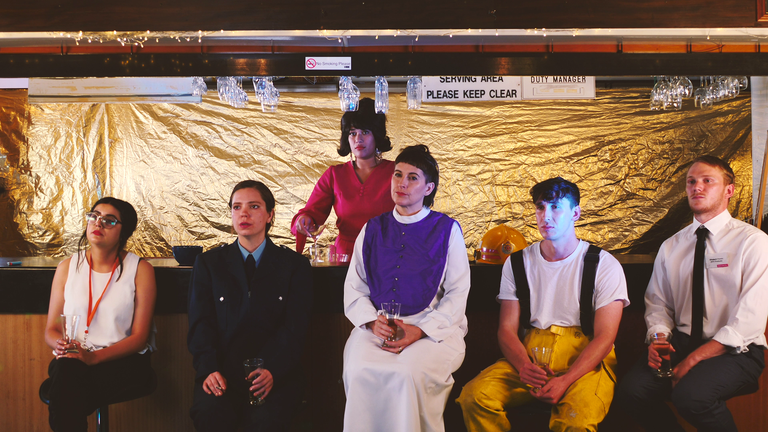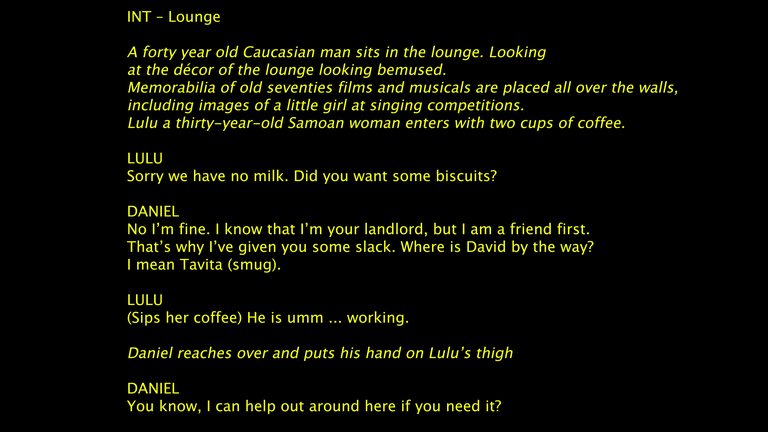Exhibition Essays
Dreaming of Lulu
March 2019
No Velvet Dreams Here
Hannah Amundsen
To dream is to envision a better future, a conscious reimagining of freedom while in reality, we are surrounded by structures of oppression. As colonised people of the Pacific, we share an affinity with struggle even in a seemingly “postcolonial” world. The conditions of our growth continue to be dependent on the environment in which we are raised, and in most cases, the privileges we are not afforded. It is apparent that in order to reframe our identity, we must imagine beyond our own physical boundaries—we must continue to dream.
For Christopher Ulutupu, the process of finding oneself is utterly entangled in envisaging Lulu. A fictional character first imagined by the artist when he was very young, Lulu has provided space for performative exploration.
Climbing the stairs to Enjoy, I could hear the faint sound of 1970s Samoan love song Se Mea a Faigata by Tiamaa. An instant spark of joy enters my heart and, like a time warp, I am transported back to family gatherings, sitting amongst singing aunties and uncles. The track recanting the oral traditions of Oceania and our people’s love for singing; it brings forth warm comfortability and a karanga to familiar grounds. Old school jams and karaoke are quintessential elements of Ulutupu’s past and present work. All three songs are sung in Samoan, allowing special access to those who are familiar with the music and the language. It is a purposeful action by the artist to privilege a genre that is popular among many Pacific Islanders and virtually non-existent elsewhere in the sphere of fine art.
As I enter the darkened gallery space, all attention is immediately consumed by a projection of three women—one playing the character of Lulu throughout—on the far wall in the video work, 3 Songs (2019). In high disco fashion and beehive wigs, they dance on the shoreline of Princess Bay. The following song is a duet between Lulu and a male performer, set in front of a green-screen collage of beaches and flowers. The last of the songs depicts Lulu and two other female performers as they orbit the Earth and fly through space. The act of dreaming is often attributed to one’s desires and fears projected through the subconscious, an interesting connection in understanding the greater ambition of this work. Ulutupu affirms that these manifestations of Lulu are parts of himself.1 She is a collage of lived experiences and a tool for agency within structure, imagined by the artist to fulfil the need to dream beyond physical limitations.

Christopher Ulutupu, 3 Songs, 2019, digital video, 16:50. Image courtesy of Xander Dixon.
The beach is a familiar environment to us, especially when Polynesian women are sharing in its space. Since encounter with Europeans a little over 250 years ago, Oceanic people have continuously been the subject of projected stereotypes for mass European consumption and subsequent colonisation; with the bodies of wāhine symbolising a submissive and welcomed entry into our lands. Lisa Taouma highlights that the dominant framework we are subjected to includes “…Polynesian women as shy alluring creatures who are sexually knowledgeable but fundamentally naïve, while the men are prone to acts of savagery.”2 These narratives are perpetuated in society today, permeating the minds and identity of our descendants.
Ulutupu has previously explored these notions of the body and belonging in nature, most notably in work The Romantic Picturesque: Ladies (2016), in which he stages the occupation of our natural landscapes by tourists. In this work, white women take the place of the dusky maiden who is removed completely from the narrative. In her place are those who pay to travel across the world and holiday in nature. The exoticism of a pre-contact maiden is stripped from the image and replaced with familiar scenes of beach chairs and chilly bins. Ulutupu has continuously renegotiated the spaces in which we are deemed “traditional” to ourselves. We experience this counter-narrative to his earlier works in Lulu, who occupies urban spaces whilst donning 70s fashion. A woman unequivocally modern but also recognisably Polynesian. We are invited to expand the imagery we hold in our own minds by diminishing the borders of culture we prescribe to people of colour, and made to question the stereotypes of beach dwellers and their urban counterparts.

Christopher Ulutupu, 3 Songs, 2019, digital video, 16:50, still. Image courtesy of the artist.
So what does it mean to have the dusky maiden archetype replaced by Lulu?
It gives her substance, that’s for sure. With winged eyeliner, kitschy 70s accessories and bright sparkly outfits, the island maiden archetypes cannot stick to her skin. She becomes an easily identifiable relative, one that many Polynesians immediately hold an affinity with in relation to their mothers, aunties and sisters. Even I possess a much-loved photograph of my grandmother that feels eerily akin to the performers of Lulu. She’s got two hands on the wheel of a vintage red boat, driving it across Lake Karapiro whilst staring down the camera with a cheeky grin. In pure Lulu fashion, she’s donning black cat eye glasses and an unshakable beehive hairstyle. My grandmother walked between two worlds before it was ever deemed normal. Having a visual representation of such mana has allowed me to accept my urbanisation as an inherited strength, not a weakness.
However, our communities often opt for more “traditional” reinventions of the Oceanic woman, ones that have been heavily altered across centuries of colonisation and assimilation. What we consider “traditional” today is, in fact, a freeze-frame of Pacific culture during the early contact period, negated to us through missionisation, ethnographic academia and the very gaze that controlled it. These are the structures that perpetuate the dusky maiden stereotype and continue to rebirth ideas of her through our own practices. An example of this is the attempted iconoclasm of ancient Hawaiian hula, which is now celebrated in two distinct categories; Hula Kahiko (predating encounter) and Hula ‘auana (heavily influenced by colonial culture). My grandmother has taught me that both are true experiences of the people and are equally valid in our modern context, however, we must acknowledge that the framework through which we view ourselves is inherently corrupt. Oceanic people are as fluid as the element we take our name from, and it is through our continuous renegotiation of these tropes that we will better understand ourselves. The relationship between the dusky maiden archetype and her modern descendant is dwindling, perhaps as our connectedness to such iconography fades. Although there is nothing wrong with affiliating with this long-established imagery, I suggest that in a globalising world, our descendants increasingly find it difficult to relate to the dusky maiden and have continued to reshape her to fit our realities.
Rosanna Raymond’s reimagining of Oceanic women as strong and almost intimidating entities allows us to respond to the structures that surround us. Her photographic work entitled Full Tusk Maiden (1999) depicts a powerful Pacific wāhine staring back into the camera. She alludes to a kinship with the dusky maiden but renegotiates her attributes to attack the viewer via a penetrating gaze that “conveys in a potent way self-possession, self-sufficiency, and agency.”3 For Polynesian people, reinventions of self through art are often concerned with the continuous reshaping of a new maiden and her counterparts, exposing her relevance to those undergoing differing degrees of decolonisation. As reflected in Ulutupu’s reinvention of Lulu, we strive to individually and collectively sift through our imagery, weeding out the impact of colonisation and replacing it with our own.

Christopher Ulutupu, What’s the worst thing I could do?, 2019, digital video, 19:43, still. Image courtesy of the artist.
Lulu normalises the hybridisation of the Pākehā and Polynesian worlds and in doing so she helps us further accept our modern identity as inherent to urbanisation. She allows us to walk in between two worlds without the restrictions of what is and what isn’t our culture; and in the process, she grants our descendants the freedom to decide who they are.
The 21st-century Islander can still whakapapa back to Moana-nui-a- Kiwa without having to adorn natural fibres. We can continue to practice our culture even when wearing European materials. Ulutupu reminds us that true empowerment in diaspora means accepting all aspects of our heritage and using our agency to mould these structures how we see fit—something that until recently I struggled to accept myself. In other words, the beach becomes a location of re-encounter with ourselves.
Dreaming of Lulu also asks the viewer to consider Lulu’s life outside of her role as an entertainer, away from song and dance. Adjacent to 3 songs is a second work called What’s the worst thing I could do? (2019), with one scene based in a kitchen and the other at the bar of your local RSA. In both scenarios, a crowd of people accumulate in the foreground wearing a series of recognisable costumes; a fireman, a policewoman, a priestess and so forth, creating a visually interesting take on the classic “three guys walk into a bar” joke with connections to Ulutupu’s real-life experiences.4 With this second work in play, the gallery space becomes a communal sitting room in which we view alongside those within the screen, awaiting Lulu’s actions to progress the storyline.
The actions performed by Lulu reflect what you could consider the servant heart of Oceanic peoples. Culturally, we labour our love through physical acts such as feeding people. I’ve seen a similar context in works of decolonisation such as Saraid Cameron’s Drowning in Milk (2018), a live performance in which women of colour serve cocktails and share their not-so-white opinions.5 These conversations, often held within the realm of fine art, work to deconstruct the struggle of working in low-income jobs overrepresented by the Polynesian population. Although Lulu does not speak during these scenes, she shows us how to breathe within these spaces—a grace I’m sure we are all envious of. Dressed to the nines, our lady in red sips wine in between serving drinks, looking unbothered by the people around her. Underneath the ocean surface, there are many undercurrents left to explore.

Christopher Ulutupu, What’s the worst thing I could do?, 2019, digital video, 19:43, still. Image courtesy of the artist.
While Tavita is at work, he will arrive with preconceived notions of accessibility to brown women. A notion received from the historical framing of our communities and the displacement of our people, sexualised and objectified as objects for the white man. He will incentivise you to submit by offering to pay your rent, even though he is your landlord anyway. The cycle continues.
Before the start of each scene, Ulutupu inserts a script, both of which jolt the viewer from a seemingly peaceful dream. The first is a conversation between Lulu and a barmaid which takes place inside an RSA, the second is dialogue between Lulu and her visiting landlord which ends in the proposition of sexual favours in exchange for him “helping out around here.” Although the landlord’s intent is made clear through his proposition, we are left unknowing of Lulu’s reaction. The lack of resolution allows the viewer to consider these issues that bubble under the surface and even the thoughts that run through her head as she prepares a meal. The indigene-coloniser hyphen is often seen as the underlying cause of societal issues stemming back to colonisation. The historic objectification of Islanders affects the frames through which we view ourselves and our hierarchical standings within these communities, which creates powerful rhetoric when reassessed within Dreaming of Lulu.
In my afterthoughts, I can’t help but wonder what Lulu ended up doing in that situation. Perhaps it bothered me not knowing. I revisited Enjoy to seek my answers within the video 3 Songs, which presents a stark and happy contrast to the script written in its counterpart. Within these narratives of racism, a situation faced by many people of different colour and creed, Ulutupu highlights the invisibility of it all but he also reminds us of our power to imagine beyond these limits. Lulu, a badass Samoan woman who, regardless of her situation, remains poised and strong. She stares down the middle of the camera, dancing, singing to love songs and wearing the most glamorous of gears. She is unphased by these obstacles and reaching above them. Even more than that, she’s singing karaoke in fucking space.
–Hannah Amundsen
Ngāti Awa, Ngāti Tūwharetoa, Kuki Airani, Pākehā
-
1.
Christopher Ulutupu, interview with the author, 13 March, 2019.
-
2.
Lisa Taouma, “Gauguin is Dead… There is No Paradise,” Journal of Intercultural Studies 25, no. 1 (2004): 35-6.
-
3.
Marata A. Tamaira, “From Full Dusk to Full Tusk: Reimagining the ‘Dusky Maiden’ through the Visual Arts,” The Contemporary Pacific 22, no. 1 (2010): 1–35.
-
4.
Christopher Ulutupu, email correspondence with the author, 21 March, 2019.
-
5.
Saraid Cameron, Drowning in Milk, Wellington: Bats Theatre: 2018.
